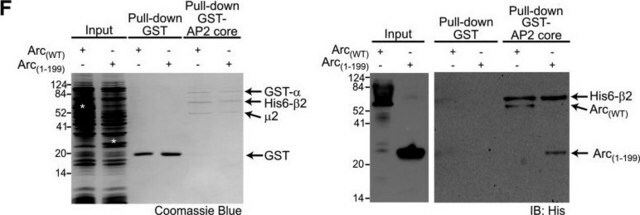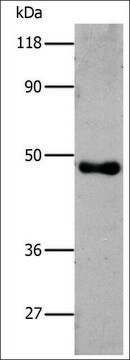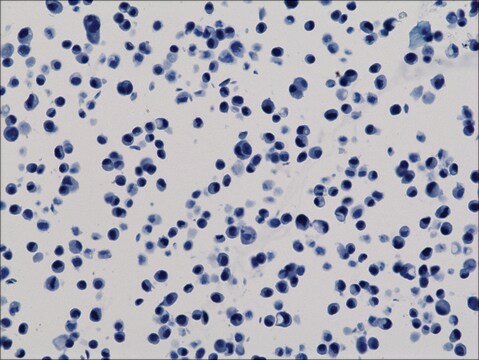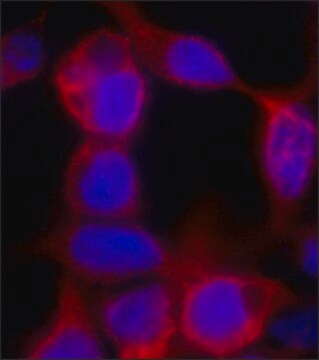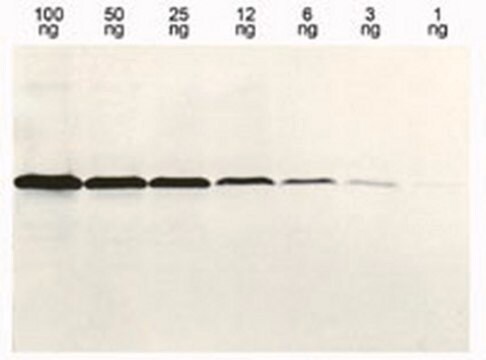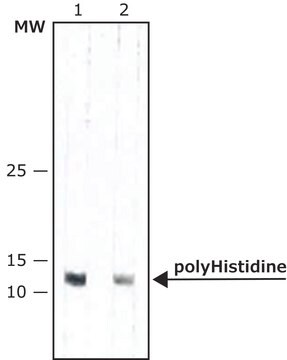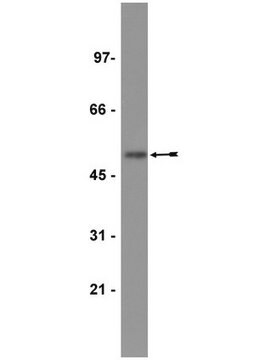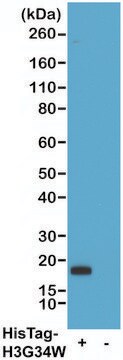11922416001
Roche
Anti-His6
from mouse IgG1
Sinônimo(s):
metal chelate affinity chromatography
Faça loginpara ver os preços organizacionais e de contrato
About This Item
Código UNSPSC:
12352203
Produtos recomendados
fonte biológica
mouse
Nível de qualidade
conjugado
unconjugated
forma do anticorpo
purified immunoglobulin
tipo de produto de anticorpo
primary antibodies
clone
monoclonal
Formulário
lyophilized
embalagem
pkg of 100 μg
fabricante/nome comercial
Roche
Isotipo
IgG1
temperatura de armazenamento
2-8°C
Descrição geral
Anti-His6 is a monoclonal antibody to His6-tagged proteins. Anti-His6 specifically recognizes an epitope of six consecutive histidine residues of both natural and recombinant proteins. The antibody reacts with native and denatured histidine-tagged fusion proteins independent of the location of the histidine-tag in the protein sequence.
Especificidade
Anti-His6 specifically recognizes an epitope of six consecutive histidine residues (His6) in natural and recombinant proteins. It reacts with both native and denatured histidine-tagged fusion proteins, independent of location of the histidine-tag in the protein sequence. In addition, Anti-His6 preferentially recognizes the C-terminal His6-epitope with high sensitivity. Anti-His6 allows specific and sensitive detection of histidine-tagged proteins irrespective of the expression system used.
The antibody recognizes an epitope of six consecutive histidine residues (His6) in natural and recombinant proteins. It reacts with both native and denatured histidine-tagged fusion proteins, independent of the epitope-sequence location.
Aplicação
Anti-His6 is used for the detection of His6-tagged proteins in:
- Immunoblotting (e.g., dot blots and western blots)
- Immunoprecipitation
- Immunoassays (ELISA)
- Immunocytochemistry
- Immunofluorescence
Nota de preparo
Stabilizers: BSA
Working concentration: Working concentration of conjugate depends on application and substrate.
The following concentrations should be taken as a guideline:
Working concentration: Working concentration of conjugate depends on application and substrate.
The following concentrations should be taken as a guideline:
- ELISA: for detection 0.1 μg/ml; for coating 1 to 5 μg/ml
- Immunoprecipitation: 0.5 to 5 μg/ml
- Western blot: 0.2 to 0.5 μg/ml
Reconstituição
Add 1 ml double-distilled water to a final concentration of 100 μg/ml.
Outras notas
For life science research only. Not for use in diagnostic procedures.
Não está encontrando o produto certo?
Experimente o nosso Ferramenta de seleção de produtos.
Palavra indicadora
Warning
Frases de perigo
Declarações de precaução
Classificações de perigo
Aquatic Chronic 3 - Skin Sens. 1
Código de classe de armazenamento
11 - Combustible Solids
Classe de risco de água (WGK)
WGK 2
Ponto de fulgor (°F)
does not flash
Ponto de fulgor (°C)
does not flash
Escolha uma das versões mais recentes:
Já possui este produto?
Encontre a documentação dos produtos que você adquiriu recentemente na biblioteca de documentos.
Os clientes também visualizaram
Aniek D van der Woude et al.
Microbial cell factories, 15, 60-60 (2016-04-10)
Erythritol is a polyol that is used in the food and beverage industry. Due to its non-caloric and non-cariogenic properties, the popularity of this sweetener is increasing. Large scale production of erythritol is currently based on conversion of glucose by
Michael Kisiela et al.
The FEBS journal, 285(2), 275-293 (2017-11-21)
The human dehydrogenase/reductase SDR family member 4 (DHRS4) is a tetrameric protein that is involved in the metabolism of several aromatic carbonyl compounds, steroids, and bile acids. The only invertebrate DHRS4 that has been characterized to date is that from
Chandrika Canugovi et al.
DNA repair, 9(10), 1080-1089 (2010-08-27)
Mitochondrial transcription factor A (TFAM) is an essential component of mitochondrial nucleoids. TFAM plays an important role in mitochondrial transcription and replication. TFAM has been previously reported to inhibit nucleotide excision repair (NER) in vitro but NER has not yet
Donghyuk Shin et al.
Molecular cell, 77(1), 164-179 (2019-11-17)
The family of bacterial SidE enzymes catalyzes non-canonical phosphoribosyl-linked (PR) serine ubiquitination and promotes infectivity of Legionella pneumophila. Here, we describe identification of two bacterial effectors that reverse PR ubiquitination and are thus named deubiquitinases for PR ubiquitination (DUPs; DupA
Archana Kumari et al.
The EMBO journal, 39(14), e104006-e104006 (2020-06-23)
Cellular studies of filamentous actin (F-actin) processes commonly utilize fluorescent versions of toxins, peptides, and proteins that bind actin. While the choice of these markers has been largely based on availability and ease, there is a severe dearth of structural
Nossa equipe de cientistas tem experiência em todas as áreas de pesquisa, incluindo Life Sciences, ciência de materiais, síntese química, cromatografia, química analítica e muitas outras.
Entre em contato com a assistência técnica
